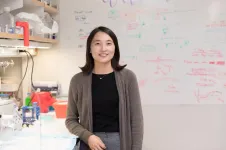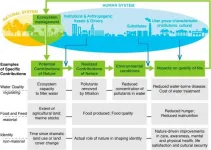(Press-News.org) The year 2021 marks the 100th anniversary of a fundamental discovery that's taught in every biochemistry textbook. In 1921, German physician Otto Warburg observed that cancer cells harvest energy from glucose sugar in a strangely inefficient manner: rather than "burn" it using oxygen, cancer cells do what yeast do -- they ferment it. This oxygen-independent process occurs quickly, but leaves much of the energy in glucose untapped.
Various hypotheses to explain the Warburg effect have been proposed over the years, including the idea that cancer cells have defective mitochondria -- their "energy factories" -- and therefore cannot perform the controlled burning of glucose. But none of these explanations has withstood the test of time. (Cancer cells' mitochondria work just fine, for example.)
Now a research team at the Sloan Kettering Institute led by immunologist Ming Li offers a new answer, based on a hefty set of genetic and biochemical experiments and published January 21 in the journal Science.
It comes down to a previously unappreciated link between Warburg metabolism and the activity of a powerhouse enzyme in the cell called PI3 kinase.
"PI3 kinase is a key signaling molecule that functions almost like a commander-in-chief of cell metabolism," Dr. Li says. "Most of the energy-costly cellular events in cells, including cell division, occur only when PI3 kinase gives the cue."
As cells shift to Warburg metabolism, the activity of PI3 kinase is increased, and in turn, the cells' commitment to divide is strengthened. It's a bit like giving the commander-in-chief a megaphone.
The findings revise the commonly accepted view among biochemists that sees metabolism as secondary to cell signaling. They also suggest that targeting metabolism could be an effective way to thwart cancer growth.
Challenging the Textbook View
Dr. Li and his team, including graduate student Ke Xu, studied Warburg metabolism in immune cells, which also rely on this seemingly inefficient form of metabolism. When immune cells are alerted to the presence of an infection, a certain type called T cells shift from the typical oxygen-burning form of metabolism to Warburg metabolism as they grow in number and ramp up infection-fighting machinery.
The key switch that controls this shift is an enzyme called lactate dehydrogenase A (LDHA), which is made in response to PI3 kinase signaling. As a result of this switch, glucose remains only partially broken down and the cell's energy currency, called ATP, is quickly generated in the cell's cytosol. (In contrast, when cells use oxygen to burn glucose, the partially broken down molecules travel to the mitochondria and are further broken down there to make ATP on a delay.)
Dr. Li and his team found that in mice, T cells lacking LDHA could not sustain their PI3 kinase activity, and as a result could not effectively fight infections. To Dr. Li and his team, this implied that this metabolic enzyme was controlling a cell's signaling activity.
"The field has worked under the assumption that metabolism is secondary to growth factor signaling," Dr. Li says. "In other words, growth factor signaling drives metabolism, and metabolism supports cell growth and proliferation. So the observation that a metabolic enzyme like LDHA could impact growth factor signaling through PI3 kinase really caught our attention."
Like other kinases, PI3 kinase relies on ATP to do its work. Since ATP is the net product of Warburg metabolism, a positive feedback loop is set up between Warburg metabolism and PI3 kinase activity, securing PI3 kinase's continued activity -- and therefore cell division.
As for why activated immune cells would preferentially resort to this form of metabolism, Dr. Li suspects it has to do with the cells' need to produce ATP quickly to ramp up their cell division and infection-fighting machinery. The positive feedback loop ensures that once this program is engaged, it will be sustained until the infection is eradicated.
The Cancer Connection
Though the team made their discoveries in immune cells, there are clear parallels to cancer.
"PI3 kinase is a very, very critical kinase in the context of cancer," Dr. Li says. "It's what sends the growth signal for cancer cells to divide, and is one of the most overly active signaling pathways in cancer."
As with immune cells, cancer cells may employ Warburg metabolism as a way to sustain the activity of this signaling pathway and therefore ensure their continued growth and division. The results raise the intriguing possibility that doctors could curb cancer growth by blocking the activity of LDHA -- the Warburg "switch."
INFORMATION:
This study received financial support from the National Institutes of Health (grant R01 AI 102888), the Howard Hughes Medical Institute, and the Memorial Sloan Kettering Cancer Center Support Grant/Core Grant P30 CA08748. The study authors declare no competing interests.
CHAPEL HILL, N.C. - Many organizations are looking at effective ways to communicate the importance of wearing a mask, especially as highly transmissible new strains of coronavirus threaten to cause a surge in infections.
Experts at the University of North Carolina at Chapel Hill suggest positive messages are critical to supporting the effort.
Their findings, described in a study published in December in the International Journal of Environmental Research and Public Health, give public health experts, leaders and communicators critical insight to craft messaging that could potentially increase mask usage during the pandemic.
"As science evolved during ...
Abnormally hyperactive areas in the brain may help better predict the onset of Alzheimer's disease, according to findings of a research team led by Université de Montreal psychology professor Sylvie Belleville, scientific Director of the Institut universitaire de gériatrie de Montréal research centre.
Hyperactivation could be an early biomarker of Alzheimer's disease, the researchers say in their study published today in Alzheimer's & Dementia: Diagnosis, Assessment & Disease Monitoring, co-authored by Belleville and Nick Corriveau-Lecavalier, a doctoral student she supervises.
Worried about their memory
In their research, ...
A new study of Type 2 diabetes (T2D) in Japanese populations has uncovered a previously uncharacterized genetic variant that puts male carriers at greater risk for the disease, as well as the mechanism by which it does so. The impact of the variant was most pronounced in sedentary men; those with the variant had a 65% greater rate of T2D than sedentary men without it.
Researchers from the University of Southern California, along with colleagues in Japan, led by Professor Noriyuki Fuku of Juntendo University, found higher rates of harmful belly fat and T2D among Japanese men with a specific mitochondrial gene variant. This variant, in the site of the mitochondrial peptide ...
Researchers from LSTM's Centre for Snakebite Research and Interventions (CSRI) have led an international team investigating the evolutionary origins of a novel defensive trait by snakes - venom spitting - and demonstrated that defensive selection pressures can influence venom composition in snakes in a repeatable manner.
In a paper published in the journal Science, the team, which includes authors from the UK, USA, Australia, the Netherlands, Spain, Norway, Brazil and Costa Rica, provide the first example of snake venom evolution being demonstrated to be associated with a role in defence, ...
Scientists have created a highly detailed map of skin, which reveals that cellular processes from development are re-activated in cells from patients with inflammatory skin disease. The researchers from the Wellcome Sanger Institute, Newcastle University and Kings College London, discovered that skin from eczema and psoriasis patients share many of the same molecular pathways as developing skin cells. This offers potential new drug targets for treating these painful skin diseases.
Published on 22nd January in Science, the study also provides a completely new understanding of inflammatory disease, opening up new avenues for research on other inflammatory diseases such as rheumatoid arthritis and inflammatory bowel disease.
Part of the global ...
ITHACA, N.Y. - A streamlined process for awarding green cards to international STEM doctoral students graduating from U.S. universities could benefit American innovation and competitiveness, including leveling the field for startups eager to attract such highly skilled workers, according to a new study by researchers from Cornell University and the University of California, San Diego.
The new Biden administration backs policy reform aimed at achieving that end, which was part of bipartisan legislation proposed more than a decade ago. But progress has been stalled by broader concerns about visas ...
LA JOLLA, CA--A big question on people's minds these days: how long does immunity to SARS-CoV-2 last following infection?
Now a research team from La Jolla Institute for Immunology (LJI), The University of Liverpool and the University of Southampton has uncovered an interesting clue. Their new study suggests that people with severe COVID-19 cases may be left with more of the protective "memory" T cells needed to fight reinfection.
"The data from this study suggest people with severe COVID-19 cases may have stronger long-term immunity," says study co-leader LJI Professor Pandurangan Vijayanand, M.D., Ph.D.
The research, published Jan. 21 in Science Immunology, is the first to describe the T cells that fight SARS-CoV-2 in "high resolution" ...
Vaccinating people over 60 is the most effective way to mitigate mortality from COVID-19, a new age-based modeling study suggests. Although vaccination of younger adults is projected to avert the greatest incidence of disease, vaccinating older adults will most effectively reduce deaths, the analysis shows. Less than one year after SARS-CoV-2 was identified, deployment of multiple vaccines against the virus has been initiated in several countries. Although vaccine production is being rapidly scaled up, demand will exceed supply for the next several months. An urgent challenge is the optimization of vaccine allocation to maximize public health benefit. To quantify the impact of COVID-19 vaccine ...
Vaccinating older adults for COVID-19 first will save substantially more U.S. lives than prioritizing other age groups, and the slower the vaccine rollout and more widespread the virus, the more critical it is to bring them to the front of the line.
That's one key takeaway from a new University of Colorado Boulder paper, published today in the journal Science, which uses mathematical modeling to make projections about how different distribution strategies would play out in countries around the globe.
The research has already informed policy recommendations by the Centers for Disease ...
It is no secret that over the last few decades, humans have changed nature at an ever-increasing rate. A growing collection of research covers the many ways this is impacting our quality of life, from air quality to nutrition and income. To better understand how which areas are most at risk, scientists have combed through volumes of literature to present global trends in the relationship between human wellbeing and environmental degradation.
Their work, which included Fabrice DeClerck from the Alliance of Bioversity International and CIAT, was summarized in "Global trends in nature's contributions to people", which was recently published in Proceedings of the National Academy of Sciences.
This systematic ...



